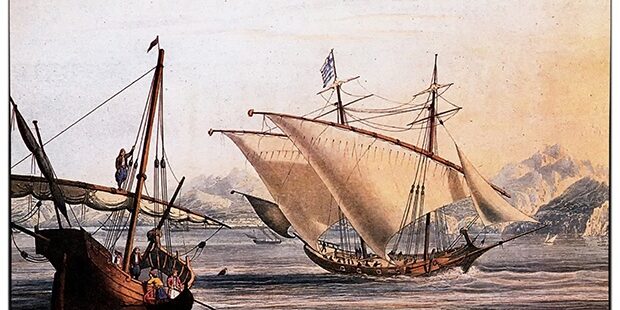Naval battle in the port of Ios
During the period 1645-1669, when the Venetians and the Ottomans were engaged in negotiations, various pirates and raiders were ravaging the Aegean Sea and clashing with the Ottomans.
Among these cruisers were the French brothers Maximilien Francois and Gabriel Ados de Themericourt, who in May 1668, arrived in Io, having been roaming the Aegean until then. They arrived in two frigates with 24 and 22 guns respectively and had two light ships for escort. In order to repair their ships, they emptied all their food and baggage into huts in the cove of the harbour. On 2 May 1668, their lookout saw over the hill 54 galleys, of the fleet of Kapudan Pasha, bringing reinforcements for the siege of Crete, approaching.
The attack was made by sea and by land, with the landing of 3,000 Yenitsars, who attacked the huts. The fight was terrible! Kapudan Captain Mustafa, the invoking “Kaplan” (tiger), attacked with fury. The Themericourt brothers acted with a clever plan. They left the care of dealing with the detachment of genitsars to two of their officers, while they tied their ships to the two ends of the harbour and joined them together so that no other vessel could enter. From there the battle was fought, which has been described as fictional. Capudan lost 500 men, 4 captains, 3 galleys, and “his cloak of woolen skin shredded by bullets”, abandoned the fight, fled in disgrace to Kimolos, and on May 6, with the appearance of the fleet of his pursuers, finally fled to Paros.
The place where this battle took place is called “Bourlotto” to this day. The names of the above mentioned Jesuit sailors have been saved by local tradition. G. Vlasopoulos, the old man Spetsiotis, Captain Dendrinos, Captain Malandris, K. Karasarinis, the old man Kontos and the old man Psarianos.
If you have a story about the island and would like to share it with us, you can contact us at iospathsgr@gmai.com or 6944682948
Subscribe to our newsletter to receive news and updates
Ναυμαχία στο λιμάνι της Ίου
Κατά τη χρονική περίοδο 1645-1669, όταν γίνονταν εχροπραξίες μεταξύ Ενετών και Οθωμανών, διάφοροι πειρατές και καταδρομείς λυμαίνονταν το Αιγαίο και συγκρούονταν με τους Οθωμανούς.
Μεταξύ των καταδρομών αυτών, υπήρξαν και οι Γάλλοι αδελφοί Maximilien Francois και Gabriel Ados de Themericourt, οι οποίοι το Μάη του 1668, έφθασαν στην Ιο οι περιφερόμενοι ως τότε στο Αιγαίο. Επέβαιναν σε δύο φρεγάτες με 24 και 22 πυροβόλα αντίστοιχα και είχαν και δύο ελαφρά πλοία για συνοδεία. Για να επισκευάσουν τα πλοία τους, άδειασαν σε παραπήγματα όλα τα τρόφιμα και τις αποσκευές τους στο μυχό του λιμανιού. Στις 2 Μαΐου 1668, ο παρατηρητής τους είδε πάνω από το λόφο να πλησιάζουν 54 γαλέρες, του στόλου του Καπουδάν Πασά, που έφερνε ενισχύσεις για την πολιορκία της Κρήτης.
Η επίθεση έγινε από θάλασσα και από στεριά, με την αποβίβαση 3.000 γενιτσάρων, που επιτέθηκαν στα παραπήγματα. Ο αγώνας ήταν φοβερός! Ο Καπουδάν Καπετάν Μουσταφά, ο επικαλούμενος “Καπλάν” (τίγρης), επιτέθηκε με λύσσα. Οι αδερφοί Themericourt έδρασαν με έξυπνο σχέδιο. Άφησαν τη φροντίδα για την αντιμετώπιση του αποσπάσματος των γενιτσάρων σε δύο από τους αξιωματικούς τους, ενώ αυτοί έδεσαν τα πλοία τους στις δύο άκρες του λιμανιού και τα ένωσαν μεταξύ τους, ώστε να μη μπορεί να μπει άλλο σκάφος. Από εκεί έγινε η μάχη που χαρακτηρίστηκε ως μυθιστορηματική. Ο Καπουδάν χάνει 500 άνδρες, 4 πλοιάρχους, 3 γαλέρες και “ο εκ μαλλωτού δέρματος μανδύας του τεμαχίζεται από τας σφαίρας”, εγκαταλείπει τον αγώνα, φεύγει επαίσχυντος προς την Κίμωλο, και την 6η Μαϊου, με την εμφάνιση του στόλου των διωκτών του καταφεύγει τελικά στην Πάρο.
Το μέρος όπου έγινε η μάχη αυτή, ονομάζεται μέχρι και σήμερα “Μπουρλότο”. Τα ονόματα των παραπάνω Ιητών Ναυτών, έχει σώσει η τοπική παράδοση: Γ. Βλασόπουλος, ο γέρος Σπετσιώτης, ο Καπετάν Δενδρινός, ο Καπετάν Μαλανδρής, ο Κ. Καρασαρίνης, ο γέρος Κοντός και ο γέρος Ψαριανός.
Αν έχετε κάποια ιστορία για το νησί και θα θέλατε να τη μοιραστείτε μαζί μας, μπορείτε να επικοινωνήσετε μαζί μας στο iospathsgr@gmai.com η στο 6944682948
Κάντε εγγραφή στο newsletter για να μαθένετε νέα και ενημερώσεις
Πηγή: Ευάγγελος Κωστόπουλος, στο έργο του Ιστορική Συλλογή της Νήσου Ίου, Αλεξάνδρεια, 1909.σελ 40







